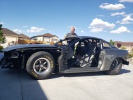
Originally Posted by
cobaltssoverbooster

Injector Ms is controlled by airmass calculations. It is like you stated, not a directly adjust parameter.
Best way to get it to climb is request more air. Raise boost by using the wastegate duty cylce table and check the knock airmass to verify it isn't limiting boost.
Pe is not just for cooling. These run really hot by design so this makes the pe ratio more fidgety. Basically you have a smaller window of error before the fuel ratio causes ignition issues.most of us start with people of lambda .86 and Dyno testing may show some applications prefer leaner towards .88.
Always keep your fuel error on point these engines are super finicky about that. Either go full maf mode or disable it and use the vve tuner built into the editor software.




 Reply With Quote
Reply With Quote
